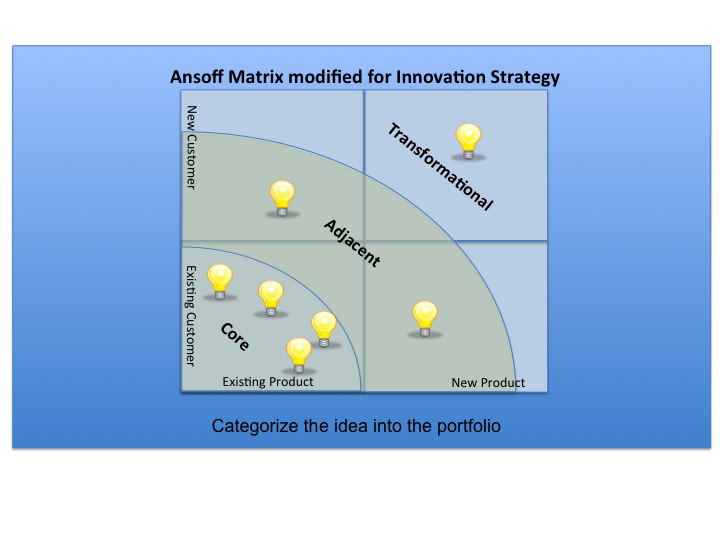One of the challenges encountered when helping corporations facilitate innovation is determining the best method to develop an idea. The method on how to turn an idea into a product, service, or internal improvement that leads to increased revenue, profits, or cost savings.
In a previous blog I discussed how to use the business model canvas and an Ansoff Matrix modified for Innovation Strategy to categorize an innovation.
There is a different Back End Innovation method you use for each of the categories, Core, Adjacent, and Transformational as defined in this Ansoff Matrix.
Core
Organizations need to have all the business functions (R&D, Sales, Marketing, Support, Distribution, etc.) required to turn ideas in the Core category into Innovations. These ideas usually lead to small revenue increases or cost savings, but they are often low-cost and quick to put into action. Therefore, these ideas are a great way to establish a solid foundation for an innovation program.
To succeed, the innovation program aims to leverage these skills to create ideas identified within the program. First, the innovation program needs to grasp how product marketing (for products and services) and operations and IT (for process improvements) get enhancement or feature requests from their existing customers. Once this process is clear, the innovation team can develop a way to integrate great ideas into these workflows.
Adjacent
Ideas in the Adjacent category are ideas where there is some small set of business capabilities that need to be significantly modified or created. For example, imagine a hardware company decides to start licensing its software. Said company probably needs to modify the sales and support channels to handle the new product.
It is often difficult for the normal organization to directly develop these changed or new business capabilities because it does not have the resources or ways of working that support business capability development. In these cases an incubation method is a great way to develop the idea. An incubation method involves creating a dedicated cross-functional team that is empowered to prototype the new product or service. The goal of the incubation team is to mature and validate with customers a prototype so that it can be integrated back into the organization. There are many ways of doing this; I prefer a combination of design thinking to flesh out the needs of your customers and lean startup to rapidly prototype, learn, and pivot.
Transformational
Ideas in the Transformational category are ideas that require significant business capability change. A good example would be a company with enterprise focused products trying to enter the consumer market. This requires significant changes to existing business capabilities.
Transformational ideas are usually very difficult to develop within an organization. The organization is built and rewarded for executing a set of current business capabilities and therefore it will resist transformational changes. Because of this it is often best to create a method for idea development that is outside the constraints of the organization. These methods often fall under the title of Mergers and Acquisitions. There are many ways these can be created which include spin-up, spin-out, spin-in, corporate venture, and eco-system development.
Does your company map ideas into the same categories? What methods does your company use for back end innovation? Tell us about it in the comments!
Read more:
